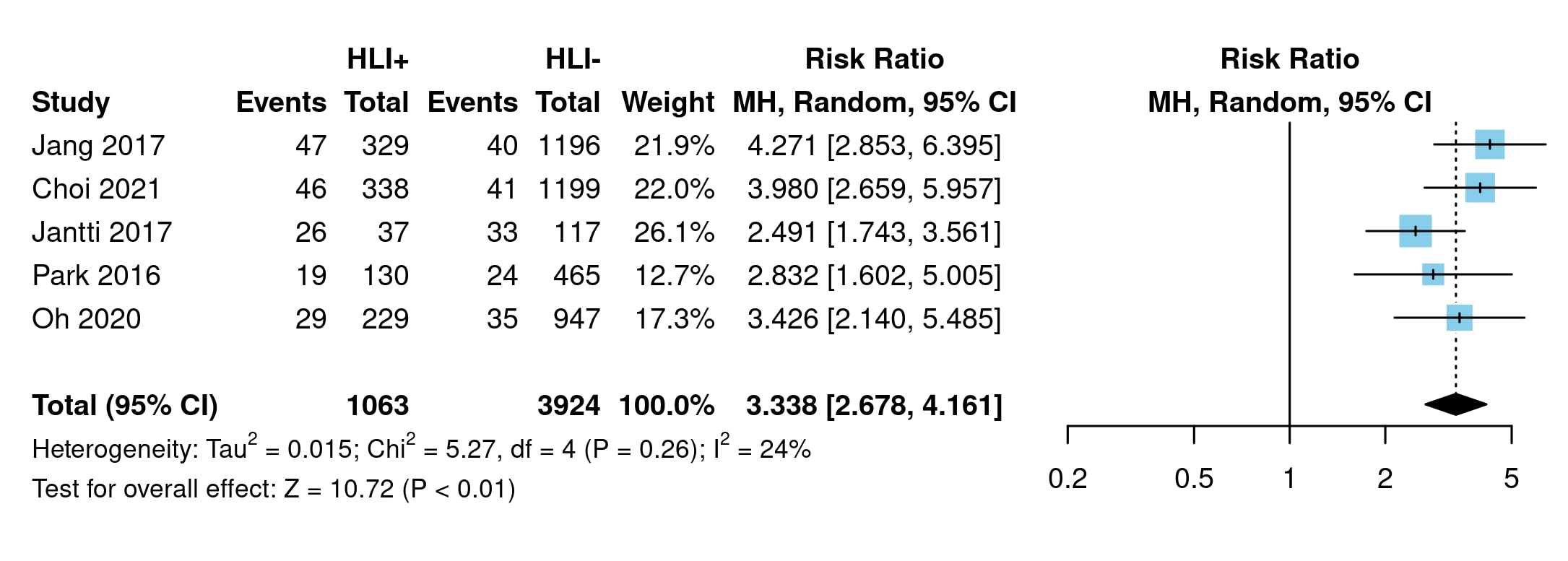Sunday Poster Session
Category: Liver
P1167 - The Role of Hypoxic Liver Injury as an Independent Predictor of Mortality in Patients With ST Elevated Myocardial Infarction: A Systematic Review and Meta-Analysis
Sunday, October 27, 2024
3:30 PM - 7:00 PM ET
Location: Exhibit Hall E

Has Audio

Nouman Shafique, MD
AdventHealth Medical Group, AdventHealth
Orlando, FL
Presenting Author(s)
Fnu Muhibullah, MD, MBBS1, Amna Ehsan, MBBS2, Nouman Shafique, MD3, Sheraz Ahmad Tariq, MBBS4, Johar Abbas, MBBS5, Muhammad Raheel Awan, MD6
1West Virginia University Camden Clark Medical Center, Parkersburg, WV; 2Nishtar Medical University, Parkersburg, WV; 3AdventHealth, Orlando, FL; 4Nishtar Medical University, Multan, Punjab, Pakistan; 5Nishtar Medical University, Hamilton, NJ; 6Carle Foundation Hospital, Champaign, IL
Introduction: ST elevated myocardial infarction (STEMI) can lead to end organ damage, resulting in conditions such as hypoxic liver injury (HLI). The role of HLI as an independent prognostic marker in STEMI patients is unclear. It is important to stratify risk of mortality in patients with STEMI for optimal management. Therefore, in this systematic review and meta-analysis, we aim to critically appraise the available literature and explore the relationship of hypoxic liver injury with mortality in patients with STEMI.
Methods: We conducted a comprehensive data search over various databases from their inception until June 2024. We included studies that quantified the relationship of HLI with mortality in a patient population with STEMI. The outcome of interest was all-cause mortality. The comparison was between patients with HLI and no HLI. A random effect meta-analysis was performed to pool the effect sizes.
Results: Five full-text studies were included, with the most common study design being retrospective cohort. Mean age ranged from 58.3 to 66 (Table). The total patient population was 4987. The prevalence of HLI in the total patient population was 21.3%. Patients with HLI were far more at risk of all-cause mortality, with a risk ratio (RR) of 3.338 [confidence interval (CI) 2.678-4.161, p < 0.01, I2 = 24%] (figure).
Discussion: HLI seems to be a novel independent prognostic marker for patients with STEMI. It can be used to stratify risk in patients with STEMI to optimize their management according to their risk of all-cause mortality. Future studies should focus on exploring a linear temporal relationship between HLI and the risk of all-cause mortality in patients with STEMI.

Note: The table for this abstract can be viewed in the ePoster Gallery section of the ACG 2024 ePoster Site or in The American Journal of Gastroenterology's abstract supplement issue, both of which will be available starting October 27, 2024.
Disclosures:
Fnu Muhibullah, MD, MBBS1, Amna Ehsan, MBBS2, Nouman Shafique, MD3, Sheraz Ahmad Tariq, MBBS4, Johar Abbas, MBBS5, Muhammad Raheel Awan, MD6. P1167 - The Role of Hypoxic Liver Injury as an Independent Predictor of Mortality in Patients With ST Elevated Myocardial Infarction: A Systematic Review and Meta-Analysis, ACG 2024 Annual Scientific Meeting Abstracts. Philadelphia, PA: American College of Gastroenterology.
1West Virginia University Camden Clark Medical Center, Parkersburg, WV; 2Nishtar Medical University, Parkersburg, WV; 3AdventHealth, Orlando, FL; 4Nishtar Medical University, Multan, Punjab, Pakistan; 5Nishtar Medical University, Hamilton, NJ; 6Carle Foundation Hospital, Champaign, IL
Introduction: ST elevated myocardial infarction (STEMI) can lead to end organ damage, resulting in conditions such as hypoxic liver injury (HLI). The role of HLI as an independent prognostic marker in STEMI patients is unclear. It is important to stratify risk of mortality in patients with STEMI for optimal management. Therefore, in this systematic review and meta-analysis, we aim to critically appraise the available literature and explore the relationship of hypoxic liver injury with mortality in patients with STEMI.
Methods: We conducted a comprehensive data search over various databases from their inception until June 2024. We included studies that quantified the relationship of HLI with mortality in a patient population with STEMI. The outcome of interest was all-cause mortality. The comparison was between patients with HLI and no HLI. A random effect meta-analysis was performed to pool the effect sizes.
Results: Five full-text studies were included, with the most common study design being retrospective cohort. Mean age ranged from 58.3 to 66 (Table). The total patient population was 4987. The prevalence of HLI in the total patient population was 21.3%. Patients with HLI were far more at risk of all-cause mortality, with a risk ratio (RR) of 3.338 [confidence interval (CI) 2.678-4.161, p < 0.01, I2 = 24%] (figure).
Discussion: HLI seems to be a novel independent prognostic marker for patients with STEMI. It can be used to stratify risk in patients with STEMI to optimize their management according to their risk of all-cause mortality. Future studies should focus on exploring a linear temporal relationship between HLI and the risk of all-cause mortality in patients with STEMI.

Figure: Figure: Forest plot of the risk ratio of all-cause mortality in patients with hypoxic liver injury in ST elevated myocardial infarction
Note: The table for this abstract can be viewed in the ePoster Gallery section of the ACG 2024 ePoster Site or in The American Journal of Gastroenterology's abstract supplement issue, both of which will be available starting October 27, 2024.
Disclosures:
Fnu Muhibullah indicated no relevant financial relationships.
Amna Ehsan indicated no relevant financial relationships.
Nouman Shafique indicated no relevant financial relationships.
Sheraz Ahmad Tariq indicated no relevant financial relationships.
Johar Abbas indicated no relevant financial relationships.
Muhammad Raheel Awan indicated no relevant financial relationships.
Fnu Muhibullah, MD, MBBS1, Amna Ehsan, MBBS2, Nouman Shafique, MD3, Sheraz Ahmad Tariq, MBBS4, Johar Abbas, MBBS5, Muhammad Raheel Awan, MD6. P1167 - The Role of Hypoxic Liver Injury as an Independent Predictor of Mortality in Patients With ST Elevated Myocardial Infarction: A Systematic Review and Meta-Analysis, ACG 2024 Annual Scientific Meeting Abstracts. Philadelphia, PA: American College of Gastroenterology.
